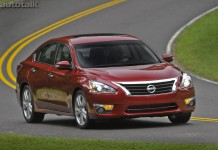In 2009, sport coupes like the Ford Mustang, Chevrolet Camaro, Nissan 370Z and BMW 335i earned another competitor to play with. Many attempts have been made to dethrone the greats but none from the very unlikely source of this new comer. A little Korean automaker, Hyundai, released their most uncharacteristic car yet which led the way for a wave of performance and efficiency. That car was the Genesis Coupe and it looked as if it was built from the default recipe in the book of sports cars. Two engines could be fitted up front, one faster than the other, and their thrust spun the rear wheels. A long hood and short deck meant the Coupe could be nothing but a sports car and for three years, it has been chasing down Zs and Mustangs on and off the track. For the 2013 model year, the sports car segment heavy weights will once again have to fend off Korea as Hyundai has altered the Genesis Coupe into a sharper tool.

Underneath, the 2013 car is essentially the same as it was in 2009. There are enough changes however to consider the Genesis Coupe “significantly redesigned” as the exterior, interior and drivetrains have all been altered. Most noticeable is the new front end which adapts numerous design cues from the smaller Veloster. The slanted and tappered nose of the first car is gone, replaced by a much more broad grille and face. Hyundai’s hexagonal design is now present as well as larger fog lights, more sculpted head lamps with new optional LED daytime running lights and a bulkier hood. Overall, these add up to a much more muscular car: more hot-rod than sports car. Moving alongside the Genesis to the rear, not much has changed from the previous edition. The short, hatchback-like rear draws over the ever-so-angular tail light section which now uses LED accents. A lower diffuser has been added to better complement the dual exhaust tips and new 18 or 19 inch wheels help fill out the fenders.




The revisions don’t stop at the exterior as the inside has gained new features as well. New seats with power lumbar adjustment for the driver have been added to complement the new telescoping steering wheel and Electroluminescen gauge cluster. A revised center stack now houses gauges for the car’s mpg, torque level on the 3.8s and boost pressure on the 2.0Ts as well as oil temperature. On leather equipped models, the amount of wrapping has increased and newly available will be Hyundai’s Blue Link telematics system. Offered on 3.8 Grand Touring/Track and 2.0T premium trims, Hyundai’s version of OnStar can be accessed via the car, smartphone or the internet. Features of Blue Link include voice text messaging, turn-by-turn directions, vehicle reporting and point of interest assistance. The first run of 2013 Genesis Coupes will get a 90 day trial period.

Just like the 2009 through 2012 Genesis Coupes, the 2013 will have two engines and two transmissions available. Both the 3.8 liter V6 and base 2.0 liter turbocharged inline four cylinder are present but this time, they’re both enhanced. The six cylinder gets gasoline direct injection for a surprising 42 horsepower boost over the multi-port injection 3.8. Power for the 2013 stands at 348 horsepower and 295 lb-ft of torque using premium fuel. Acceleration is obviously improved and the 3.8 can now hit 60 mph in the low five second range. More extensive changes can be found under the hood of the 2.0T as power has increased by a massive 30 percent over the 2012 turbo. This was accomplished by a new, twin-scroll turbocharger, larger intercooler, more boost and a larger exhaust. Where the first run 2.0 liter Genesis Coupes were simply adequate, the 2013 could really do some damage with its new-found 274 horsepower and 275 lb-ft of torque with premium fuel. Both blocks have the ability run perfectly fine, albeit with lower outputs, on regular grade gas. Base transmissions for both engines is the carry over six speed manual but automatic drivers now gain two extra speeds. Borrowed from the Genesis Sedan and Equus is the Hyundai in-house built eight speed automatic which can be paired with both the 3.8 and 2.0T. This smoother-than-glass slushbox allows bot engines a bump in fuel economy. On the highway, the auto 3.8 and 2.0T can achieve 28 mpg and 31 mpg respectively. In Track form, a Torsen limited slip differential will ensure that the 2013’s added power will make any Genesis Coupe extra sideways.


Official pricing as well as total trim numbers have yet to be revealed. There will be the Grand Touring, Track, R-Spec and Premium versions but there could be one or two more. Expect the 2013 Hyundai Genesis Coupe to hit showroom floors later in the year. Once they begin their prowl on the streets, expect the likes of the Ford Mustang and Nissan 370Z to put their guard up as Hyundai has built one seriously competitive sports coupe.
Source: Hyundai









